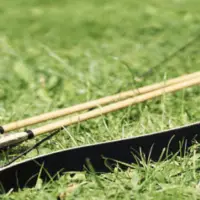Shooting a bow, the steadier you hold it, the easier it’s going to be consistent with it. I wanted to learn how to improve stability with a bow, and here I’ll share what I’ve learned with you.
I’ve detailed the different things that might affect your stability into a 6-step checklist process you’ll need to follow. By going through this process, you’ll be sure to work on all the major things that influence your stability.
Step 1: Work on your shooting posture
The first thing we’re going to consider when discussing how stable you are with your bow is your shooting posture.
You must understand that your archery abilities have a lot to do with technique, and not only with strength. Your posture will determine how consistent you’ll be, and a big part of that is because it affects your stability.
There are actually a lot of different things you might want to work on when considering your shooting posture. I’ve actually detailed many of them into a guide about archery shooting form you’ll benefit from reading. But here we’ll discuss the most common mistake you might be making.
The first thing you should consider is the positioning of your legs. Since it’s the base of your body, it has a lot to do with your overall stability.
There are 3 common stances you might use, where the most common one is the square stance. In this stance, you place your feet will point forward, and the target will be on your side. I’d recommend mastering this stance if you’re a beginner.
No matter what stance you choose, you should make sure your feet are grounded and about shoulder-width apart. Keep them relaxed and make sure your base feels stable.
Your grip also has a lot to do with your bow stability. It’s a common mistake to grab the bow harshly with your holding hand. That can cause your muscles to shake, moving the bow around.
Make sure to have a relaxed, light grip on the bow. Your holding hand should simply rest on the bow, and the weight of the bow will keep it in place. Your fingers should be completely relaxed.
By using the weight of the bow instead of your muscles, which are an unstable base, you’ll feel much more stable.
The last thing we’re going to discuss here is your shoulders. Having shrugged, overextended shoulders can cause a lot of stress on your muscles, tiring them and making them shake.
Make sure when shooting that your shoulders are in their natural position, and a relaxed. Don’t pull them up or down, just let them rest in place.
An easy way to make sure your shoulders are correctly positioned is to pull your shoulder blades together. You’ll feel your shoulders pushed to their correct position, and the pull will indicate you need to change your posture. This will also eliminate most rounding of your shoulders, which is a major issue for your accuracy and overall posture.
Of course, these are just some specific posture tips you might find useful, specifically for your stability. Working on your shooting posture is always a good idea, which will benefit you both in the short and long term.
Step 2: Lower your draw weight
Another big component with your ability to hold the bow steady at full draw is your draw weight. That’s basically how much weight the archer pulls and holds when drawing the bow.
If the bow is set to a draw weight too high for you, you’ll have a draw time holding it at full draw. At some point, this can actually be dangerous, but for most archers, this only means that your muscles will shake and that you won’t be able to hold the bow in place.
To check if that’s the case, I suggest you find check if it feels physically hard to pull the bow. If you can, try shooting a lower draw weight bow and see if you feel unstable with lower draw weights as well.
I actually wrote a post about measuring and adjusting your bows’ draw weight. A big part of the post is about what your draw weight should be, and I think it’ll really help you if your issue is with the draw weight.
Step 3: Check your draw length
The draw length is another critical component of the stability of your bow. This is simply the length that you have to pull the bow from the resting position to full draw. This distance should fit your body’s natural proportions.
Shooting a draw length too short for you can easily cause your bow to feel unstable. A draw length too high will cause you to overextend and not allow you to shoot with proper posture.
If you’re able to properly align yourself, and your bow feels shaky, it might be a low draw length. You may try to follow my guide to checking what’s your ideal draw length and adjust your bow accordingly. You can also get your bow to a pro shop.
I’d also suggest you flim yourself shooting from the side. This way, you’ll be able to see if your bow fits it.
Step 4: Check your breathing
You’d be surprised how important breathing is for your ability to properly aim your bow. Not only do the breathing affect the stability of your bow, but it also affects your mental state.
But let’s focus on the bow stability. If you’ve anchored the bow and trying to aim while breathing normally, you’ll see that your bow is much harder to hold steadily.
There is a correct way to breathe that’ll eliminate this issue. Between raising your bow and until you’re at full draw, you’ll breathe normally from your diaphragm. At full draw, you’ll breath out to around 50% of the air, and then hold your breath until the follow-through. Let the air out slowly when following through.
By holding your breath you’ll eliminate the inherent instability your breath introduces to your bow. You’ll be able to aim the bow much better.
If you take too long to aim, you can take a small break, breathe normally to relax, then begin holding your breath again and continue aiming.
Mastring breathing will increase your stability and overall performance.
Step 5: Practice bow stability (muscle conditioning)
As time goes on, if you practice shooting your bow, your muscles will get used to the tension and you’ll be able to hold it steadier.
It might sound a bit obvious, but practice makes perfect. Try involving yourself in longer training sessions, so you get to the point where your muscles are stimulated.
A great option to work directly on conditioning your muscles is to do some blank bale shooting. That’s the process of shooting up close to a target without a face, so you can focus on the actual process of the shot instead of aiming.
You’ll try to shoot exactly the same way every shot. Over time you gain muscle memory, improve your consistency, and reduce the sight movement.
I wouldn’t suggest going all the way and only doing blank bale shooting for a while. Try incorporating it into your training routine. A combination of normal practice and some dedicated exercises will help you quickly condition your muscles and stabilize your bow.
Step 6: Consider using a stabilizer
While stabilizers can be really beneficial for many archers, I’ve decided to put this step last. That’s because adding accessories increases the complexity of your gear, and has a financial cost you might want to avoid.
With that in mind, if you feel you’re at the edge of your current capabilities, adding a stabilizer to your bow can significantly increase your ability to hold the bow steadily.
Stabilizers help to balance your bow out and increase your ability and ease of holding and aiming it. Almost all high-level archers use stabilizers of various lengths.
Longer stabilizers will increase the stability of your bow, but also add more weight to it and make it less mobile. Shorter archers stabilize your bow less but are easier to move around with.
That’s why most target archers favor longer rods on their stabilizer, while mobile style archers typically use shorter stabilizers.
I actually wrote an entire post on stabilizers, that can help you decide whether you need a stabilizer on your bow, and how to pick one. I’ll walk you through everything you need to consider.
Conclusions
We’ve discussed an entire process of making your bow steadier when you’re aiming. The major different causes of instability will be fixed by following this process.
Since bow stability is such an essential part of your ability to aim, I’d recommend any archer go through this list and check whether there are some things they can do to improve this accuracy.
Of course, how you aim affects your accuracy. Even if you have a stable hold on the bow, but you’re aiming incorrectly, you’ll have a really hard time being consistent. Make sure to perfect every part of your shot process, especially your aiming,
With that in mind, I hope this post was helpfull. Enjoy!



